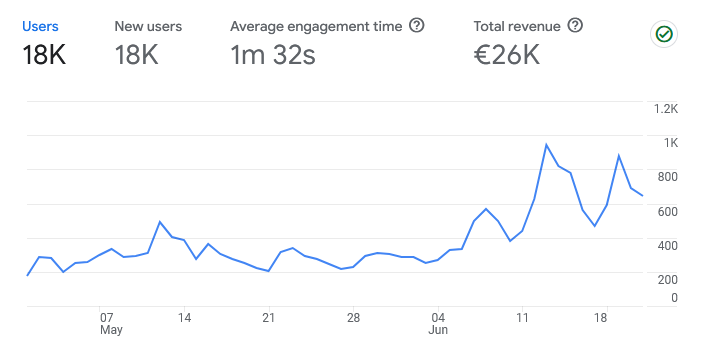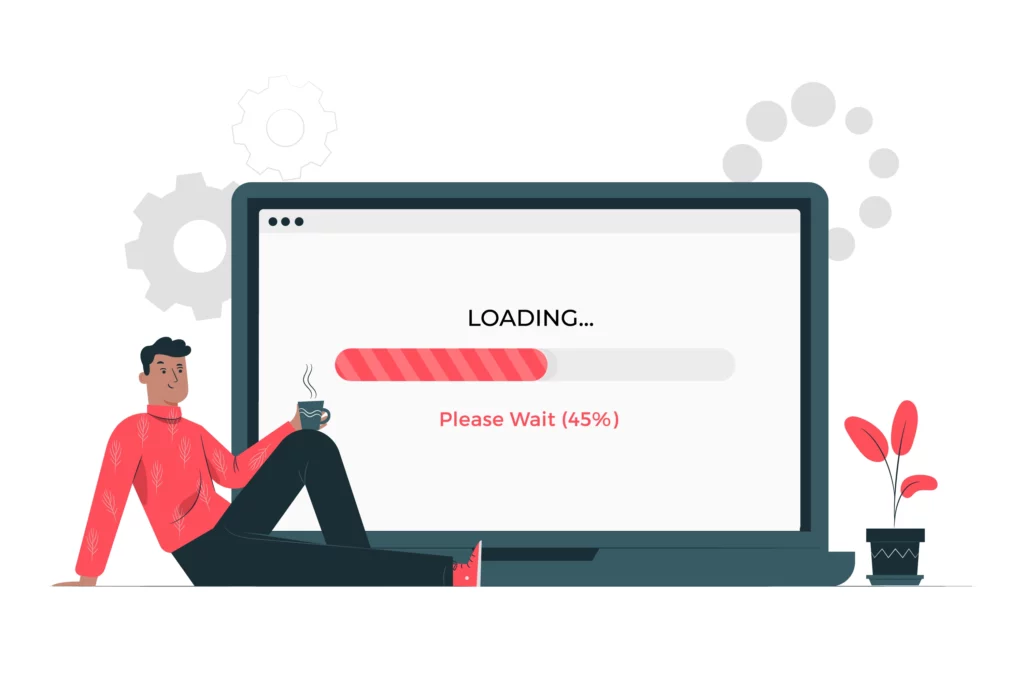Achieving goals and increasing conversions are key elements for the success of websites and stores. Whether you offer products or services, your goal is to convert visitors into actual customers. However, this is not an easy task as you have to face various challenges such as competition, user experience, content, and authority. In this article, we'll explore how to achieve goals and increase conversions on your website or store, and walk you through the key steps to success.
- Understanding goals
- Analysis of the current situation
- User experience (UX) optimization
- Creating effective calls to action (CTAs)
- Building trust and authority
- Using relevant content
- Testing and monitoring results
- Monitoring the competition
- Continuous improvement and adaptation
- Conclusion
Understanding goals
How to set meaningful and achievable goals for your website or store
When setting goals for your website or store, it’s important to consider whether they are meaningful and achievable. Meaningful goals are those that align with your business strategy and contribute to the long-term success of your business. Whether you want to increase sales, gain more email newsletter subscribers, or increase downloads of your mobile app, your goals should align with your main purpose and vision.
In addition to being meaningful, goals also need to be achievable. This means they need to be realistic and reachable within a certain time frameWhen setting goals, consider the current capabilities of your website or store and the available resources such as time, money, human resources, and technological infrastructure. Goals should be set in a way that can be achieved through the proper allocation of resources and the implementation of appropriate strategies.
The importance of defining key metrics to monitor progress
When you have specific goals, it is crucial also define key metrics, which you will use to track progress towards these goals. Key metrics are quantitative indicators of success that allow you to objectively assess the performance of your website or store.
For example, if your goal is to increase sales, key metrics might include total sales, average purchase value, visitor-to-customer conversion rate, number of repeat customers, etc. By monitoring these metrics, you can determine exactly how well your website or store is performing and where improvements are needed.
Additionally, defining key metrics also allows you to compare progress over time or across different marketing campaigns. This helps you identify trends, identify successful strategies, and identify potential problems or opportunities for improvement. Key metrics are therefore the foundation for monitoring the success of your website or store and allow you to adjust your strategy based on the data collected.
By setting meaningful and achievable goals and identifying key metrics to track your progress, you have a solid foundation for achieving your goals and increasing conversions on your website or store. In the following sections of the article, we will explore steps for optimizing the user experience, crafting effective calls to action, building trust and authority, and other key aspects that influence conversions.
Analysis of the current situation
How to assess the current state of your website or store
To effectively improve conversions, it's important to first assess the current state of your website or store. This assessment will help you identify strengths, weaknesses, and opportunities for improvement. Here are some steps to help you with this assessment:
- Web Traffic Analysis: Start by analyzing your web traffic. Use tools like Google Analytics to gain insight into visitor numbers, traffic sources, bounce rates, and other key metrics. Also review the demographics and interests of your visitors. This analysis will help you understand who your visitors are and how well you are reaching your target audience.
- User Experience Review: Examine the user experience on your website or store. Check if your page is easy to navigate, if the information is clear and accessible, if the design is attractive and responsive on different devices. Test the checkout or form filling process to make sure it is simple and intuitive. Identify any problems or obstacles that could reduce conversions.
- Content Audit: Analyze the content on your website or store. Check if the content is engaging, informative, and tailored to your target audience. Also examine the quality of text, images, videos, and other media elements. Determine if the content clearly represents the benefits of your products or services and encourages users to take action.

Identification of weak points and opportunities for improvement
Once you have assessed your current situation, the next step is to identify weaknesses and opportunities for improvement. Here are some key areas to review:
- User Experience: Identify any user experience issues. This includes slow page loading, complex navigation elements, unclear content layout, or difficulties filling out forms. Identify weaknesses and find solutions to improve the user experience.
- Calls to Action (CTAs): Check the effectiveness of your calls to action. Are they engaging, clear, and encouraging visitors to take the desired action? Consider adjusting the text, design, or location of your CTA buttons to increase conversions.
- Mobile-Friendly: Check if your website or store is mobile-friendly. More and more visitors are using mobile devices, so it's crucial to ensure that your website displays and functions correctly on different mobile platforms.
- Content: Make sure your content is relevant, engaging, and tailored to your target audience. Update or improve your content to better address your visitors' needs and wants.
- Online security: Check the security status of your website or store. Make sure that the website is protected from potential attacks and abuse, as poor security can negatively affect visitor trust.
By identifying weak points and opportunities for improvement, you can focus your efforts on improving conversions. Use the information you gather to plan and implement strategies that will improve the user experience and increase conversions on your site. online store or website.
User experience (UX) optimization
The importance of a good user experience in achieving goals and increasing conversions

A good user experience is crucial to achieving your goals and increasing conversions on your website or store. Users have high expectations for ease of use, loading speeds and responsiveness of the website, and clear and intuitive navigation. Here are some reasons why a good user experience is important:
- First Impression: Users will form their opinion of your website or store within seconds. If the first impression is negative due to slow loading or confusing navigation, they are likely to leave your site and turn to your competitors. A good user experience provides a positive first impression that encourages visitors to explore your offerings.
- Conversions: A good user experience increases the likelihood that visitors will convert into customers. Easy navigation, clear calls to action (CTAs), and simple form completion help drive more conversions. If the purchase or registration process is complicated or lengthy, many visitors will choose to leave the site before completing it.
- Customer Satisfaction: A good user experience not only drives conversions, but also boosts customer satisfaction. If customers are happy with the user experience on your online store or page, they are more likely to remain loyal, shop again, and even recommend your business to others.
Tips for improving navigation, loading speed, responsiveness, and ease of use

- Clear and simple navigation: Make sure your navigation is clear, logical, and easy to use. Menus should be well-organized, categories should be understandable, and links should be labeled in a way that clearly shows where they lead. Make sure the search box is clearly visible and allows for quick searches across the site.
- Loading speed: Optimize loading speed your website or store. Slow loading pages reduce the user experience and increase the chances of visitors abandoning your site. Make sure to compress images, reduce the number of scripts and external resources required, and choose quality hosting that ensures fast responsiveness.
- Responsiveness across devices: Users access the web from a variety of devices, so it’s crucial that your website is responsive. Ensure that it scales and displays properly on mobile phones, tablets, and other devices. Test your site on different devices and operating systems and troubleshoot any display or performance issues.
- Ease of Use: Simplify the user experience on your website or store. Remove unnecessary steps or requirements when making a purchase or registering. Reduce the amount of required information users need to enter and make it easy to fill out forms with autofill or select.
- User Experience Testing: Conduct user experience tests, either through user testing or by analyzing user feedback. Monitor how users interact with your website and seek feedback on any issues or obstacles. This information will allow you to improve the user experience and increase conversions.
By improving navigation, loading speeds, responsiveness, and ease of use will create a better user experience that will drive more conversions on your website or store. Pay attention to these aspects and constantly improve the user experience to achieve your goals and achieve success.
Creating effective calls to action (CTAs)
How to design attractive CTA buttons, links, and notifications

Designing attractive CTA buttons, links, and notifications is crucial to encouraging users to take action on your website or store. Here are some tips on how to design attractive CTA buttons, links, and notifications:
- Color appeal: Use colors that stand out and grab users’ attention. Make sure the color of the CTA button or link contrasts with the background. Choose colors that are consistent with your brand and create the desired atmosphere, such as strong and energetic colors to encourage a purchase or sign-up.
- Size and shape: CTA buttons should be large enough to be noticeable and easy to click on across devices. Also consider using rounded edges or other shapes that will make CTA buttons more visually appealing.
- Clarity and readability: The text on the CTA buttons, links or notifications should be clear and readable. Use fonts that are large enough to be easily visible. Be careful with the choice of text and background colors to ensure high readability.
- Follow the text: Use text that calls to action and conveys the value the user will receive when they take the desired action. Use compelling words like “Choose Now,” “Discover More,” or “Join an Exclusive Community.” Be clear and concise to quickly grab attention.
Using compelling text and visuals to encourage users to take action
How to convince users to take the desired action on your website or shop? In addition to designing attractive CTA buttons, links, and notifications, it's also important to use compelling text and visuals. Here are some tips:
- Highlight the benefits: In the text of your CTA buttons or links, highlight the benefits users will get when they take action. For example, if you want users to sign up for your newsletter, highlight the exclusive offers, helpful content, or regular updates they will receive.
- Add visuals: In addition to text, use visuals that encourage users to take action. For example, you can add icons, images, or graphics to your CTA buttons or links that highlight the desired action or represent the benefits users gain.
- Social proof: Include social proof, such as customer testimonials, ratings, or recommendations. Users often make decisions based on the opinions of other users, so positive social proof will build trust and increase the likelihood that they will take the desired action.
- Create a sense of urgency: Use text or visuals that create a sense of urgency. For example, add a limited time offer with a time limit or number of spots available. This encourages users to take action immediately so they don't miss out on the opportunity.
- Personalization: Tailor CTA buttons, links, or notifications to specific segments of your target audience. Use personalized text or visuals that are relevant to individual users, such as based on their website behavior or demographics.
By designing attractive CTA buttons, links, and notifications, and using compelling text and visuals, you will increase the likelihood that users will take the desired action on your website or shopFollow the tips above and tailor your CTA buttons, links, and notifications to your target audience. By combining visual appeal, compelling text, and creating a sense of urgency, you will encourage more users to take action, which will help increase conversions and achieve your goals.
Building trust and authority
Why trust is key to converting visitors into customers
Trust is key to converting your website visitors into customers. When visitors trust your business, products, or services, they are more likely to make a purchase or take another desired action. Here are some reasons why trust is so important:
- Eliminates doubts: Many website visitors face doubts and uncertainty when it comes to making a purchase or performing other actions. Trust helps eliminate these doubts and provides feeling of security and trustworthiness. When visitors trust you and your business, they are more likely to trust you with their money, time, and personal information.
- Increases credibility: Trust helps you build credibility and reputation. When visitors recognize your business as credible and trustworthy, they are more likely to do business with you over your competitors. Credibility is key to building long-term customer relationships.
- Encourages repeat purchases: Trust has a long-term impact on customers. When you have the trust of your customers, they are more likely to return and make repeat purchases. Trust creates loyalty because customers know they can expect consistent quality and satisfaction when doing business with you.
Methods for building trust through displaying references, certificates, customer reviews, etc.
Building trust is an important process that requires active steps. There are several methods you can use to build trust on your website or store. Here are some effective methods:
- Testimonials: Showing testimonials from customers who have been satisfied with your products or services is a great way to build trust. Showing positive experiences from other customers tells visitors that your company is reliable and trustworthy. Use quotes, reviews, or customer case studies that demonstrate positive results.
- Certifications and Awards: Displaying certificates, awards, or recognitions your company has received can further build trust. Certifications highlight your expertise, quality standards, and compliance with industry guidelines. Include certification icons or graphics on your website so visitors can immediately notice them.
- Customer Reviews: Displaying customer reviews is a very effective way to build trust. Use displays of reviews, ratings, or comments from customers who have expressed satisfaction with your products or services. You can also include customer names and images if you have their consent. This creates a sense of authenticity and allows users to more easily relate to other customers’ experiences.
- Social proof: Social proof, such as the number of social media followers, the number of social media shares, or popularity in the media, also builds trust. Displaying this evidence tells visitors that your business is recognized and respected in the industry.
- Customer Satisfaction: Commit to providing excellent service and ensuring customer satisfaction. If customers are happy with the experience and results, they will be more willing to share their positive experiences with others. This creates a positive public opinion and further builds trust in your business.
Trust is key to converting visitors into customers. By using trust-building methods like displaying testimonials, testimonials, customer reviews, and social proof correctly, you will strengthen users’ trust in your website or store. Make sure this information is visible and easily accessible in relevant places, such as your homepage, product or service pages, and on sign-up or checkout pages. Also, focus on providing exceptional customer service to create happy customers who are willing to share their positive experiences. By combining these methods, you will build trust and encourage more visitors to convert into customers.
Using relevant content
How to create quality and relevant content to attract your target audience

Creating quality and relevant content is key to attracting and engaging your target audience on your website or store. With quality content, you will establish your expertise, educate your audience, and build trust. Here are some tips on how to create quality and relevant content:
- Target Audience Research: Get to know your target audience thoroughly – their needs, interests, problems and goals. Research what they are interested in, where they look for information and what challenges they face. This will help you create content that is relevant and useful to your audience.
- Define content goals: Determine what goals you want to achieve with your content. Do you want to educate your audience, drive a purchase, increase brand awareness, or establish expertise? Clearly define your goals so you can guide your content and measure its success.
- Choose the right formats: Consider different content formats that suit your goals and audience preferences. This could include articles, blog posts, infographics, videos, e-books, podcasts, case studies, etc. Choose the formats that best communicate your message and adapt to the habits and needs of your target audience.
- Offer unique and valuable information: Your content should be unique and offer valuable information. Be innovative, research topics that are relevant to your audience, and provide quality and credible sources. Offer solutions to your audience’s problems and help them achieve their goals.
- SEO Adjustment: Take Note web optimizationSearch engine optimization (SEO) helps your content become more visible and reachable to your target audience. Research keywords that are relevant to your content and include them in your titles, subheadings, meta descriptions, and content structure. Proper use of SEO will help increase organic traffic to your website.
The connection between content and goal conversions
Quality content plays an important role in driving targeted conversions on your website or shopContent has the ability to build trust, educate your audience, influence decisions, and create engagement. Here are some ways content impacts goal conversions:
- Education and awareness: With quality content, you can educate your audience about your products or services, the benefits of using them, and how they work. When your audience better understands how you can help them solve their problems or achieve their goals, they are more likely to make the desired conversion.
- Build trust: Quality content helps build trust between you and your audience. When visitors recognize your expertise, usefulness, and value, they are more likely to trust you and your products or services. This increases the likelihood that they will make the desired conversion.
- Calls to action: Content can also include clear calls to action (CTAs) that encourage your audience to take the desired conversions. With quality content, you can create a need for action and inspire your audience to fill out a form, make a purchase, or take another desired action.
- Personalization: Creating personalized content that targets specific segments of your target audience can increase the likelihood of conversions. When content is tailored to your audience’s needs, interests, and challenges, they feel more connected and understand how your products or services can help them achieve the results they want.
- Analytics Tracking: By tracking analytics, you can measure the performance of your content and see how it impacts conversions. Analyze data on visitors, interactions, time spent on page, bounce rates, etc. Use this information to improve your content and adjust your strategy for better conversions.
Quality content that is tailored to your target audience has a strong correlation to targeted conversions. Commit to creating quality content that is relevant to the needs and interests of your target audience. Research, create unique content, optimize it for SEO, and use effective calls to action to drive your audience to the conversions they want. Track analytics to measure your content’s performance and adjust your strategy for even better conversions. By taking a consistent approach to creating quality content, you will increase the appeal of your website or shops and encourage visitors to perform targeted conversions.
Testing and monitoring results
Why testing different approaches and monitoring analytics is key to improving conversions
Testing different approaches and tracking analytics are key to improving conversions on your website or store. This allows you to understand how visitors interact with your content, design, and functionality, and to refine your strategies. Here are some reasons why testing and analytics are important:
- Identifying Effective Approaches: Testing different approaches allows you to determine which elements or strategies lead to higher conversions. You can try different headlines, copy, color schemes, layouts, CTA buttons, etc. Tracking the results of your testing helps you identify best practices and adjust your content or design based on the findings.
- Understand visitor behavior: Tracking analytics helps you understand how visitors behave on your website. You can find out where they leave the page, which pages have the highest conversion rates, how much time they spend on each page, etc. This allows you to identify problems or obstacles that visitors are facing and address them to improve conversions.
- Target Audience Customization: Testing and analytics allow you to tailor your approaches to your specific target audience. You can segment your visitors based on demographics, behaviors, or interests, and test which approaches work best for each group. This will help you better meet the needs and expectations of your audience and increase the likelihood of conversions.
- User Experience Optimization: Testing also allows you to optimize the user experience. By testing different forms and functionalities, you can improve navigation, loading speed, responsiveness, and ease of use. When visitors experience a better user experience, they are more likely to stay on the site, complete the desired conversion, and return in the future.
Using A/B testing tools and tracking progress
To successfully test and monitor your analytics, you can use A/B testing and progress tracking tools. These tools allow you to run experiments and analyze results in an easy and systematic way. Here are some popular tools:
- Google Analytics: Google Analytics is a free tool that allows you to track traffic to your website, analyze visitor behavior, and measure conversions. It also allows you to set goals and track their performance.
- Optimizely: Optimizely is an A/B testing and personalization tool that lets you run experiments on your websites and test different approaches. You can track the results of your testing and adjust your content or design based on the data you get.
- Hotjar: Hotjar is a tool for tracking visitor behavior using features like heatmaps, visitor recordings, and surveys. This helps you understand how visitors interact with your website and where potential problems lie.
- Crazy Egg: Crazy Egg offers features like heatmaps, click maps, and visitor recording. This helps you visually show how visitors use your website, where they click, and where they scroll.
- Visual Website Optimizer (VWO): VWO is a comprehensive A/B testing, visitor behavior tracking, and analytics tool. It allows you to test different approaches, track conversions, and optimize the user experience.
Using A/B testing and tracking tools allows you to take a systematic approach to improving conversions. Try different approaches, analyze the results, and adjust your strategy based on the data you collect. This will help you achieve better results and increase conversions on your website or store.
Monitoring the competition
How can we learn from our competitors and leverage their successful strategies?
Competitors can serve as a valuable source of inspiration and learning. By analyzing your competitors, you can discover the successful strategies your competitors are using and leverage them to improve your business. Here are some ways you can learn from your competitors and capitalize on their successful strategies:
- Analyze their online presence: Review your competitors’ websites and stores. Pay attention to their design, user experience, content, call-to-action (CTA), and conversion performance. Find out what they do well and how you can use it to your advantage.
- Gain insight into their marketing strategies: Analyze the marketing channels your competitors use, such as social media, email, online advertising, etc. Study what types of content they publish, what goals they pursue, and how they interact with their audience. This can help you identify successful approaches that you can incorporate into your strategy.
- Track their key metrics: Find out what key metrics your competitors are tracking, such as visitor count, conversion rate, average purchase value, etc. This will allow you to evaluate their performance and compare it to your results. If you see that your competitors are performing better in certain metrics, consider adjusting your strategy.
- Study their products or services: Analyze the products or services offered by your competitors. Look at their features, quality, prices, packages, and promotions. Find out what sets them apart from the rest and how you can improve your offering.
- Monitor their customers: Study feedback and reviews from customers who have experienced your competitors’ products or services. This can reveal what customers value and where you can improve your offering. Also, consider how your competitors respond to negative reviews and complaints, and how they maintain good customer relationships.
Competitive analysis to discover new opportunities
Competitive analysis allows you to discover new opportunities to improve your business and outperform your competition. Here are some steps you can consider when conducting a competitive analysis:
- Identify key competitors: Find out who your main competitors are in the industry. Examine their size, market position, target audience segments, unique selling points, and online presence.
- Analyze their products or services: Review what products or services your competitors offer. Find out how their offerings differ from yours and what makes them attractive to customers. Consider how you can improve your offerings or develop new products that will stand out in the market.
- Examine their marketing strategy: Study the marketing channels your competitors use and find out how they communicate with their audience. Check out what marketing tactics they use, what content they create, and how they present themselves in the market.
- Monitor their target audience: Research who their target customers are and how they target them. Look for similarities and differences between their target audience and yours, and consider how you can tailor your communications to reach the same or similar target group.
- Assess their key strengths: Find out what your competitors are strong at and what makes them unique. Examine their strengths such as quality, speed of delivery, price, customer service, etc. Think about how you can leverage these findings to improve your competitive advantage.
- Monitor changes and innovations: Regularly monitor your competitors' activities and pay attention to their changes, such as new products, marketing campaigns, business models, etc. Also pay attention to trends and innovations in the industry and adapt to stay competitive.
- Conduct a SWOT analysis: Conduct a SWOT analysis (Strengths, Weaknesses, Opportunities, and Threats) on your competitors. This will help you understand their strengths, weaknesses, potential, and challenges. Based on these findings, you can formulate your strategy and focus on opportunities that your competitors may not be exploiting.
Competitive analysis allows you to gain industry insight, improve your business, and discover new opportunities and strategies for success. However, it is important to conduct the analysis objectively and not blindly copy your competition. Instead, focus on identifying opportunities for improvement and developing your unique value proposition for customers.
Continuous improvement and adaptation
Why continuous improvement is key to long-term success
Continuous improvement is key to the long-term success of your website or store. The dynamism of the web, changing customer needs, and ever-changing business environments require flexibility and constant upgrading. Here are some reasons why continuous improvement is key:
- Changes in customer needs: Customer needs and expectations are constantly changing. Therefore, it is important to adapt your website or store to meet these changing needs. By continuously improving, you can get feedback from customers, analyze trends, and adjust your offerings, content, and functionality to stay relevant and competitive.
- Competitive environment: The business environment is dynamic, and competitors are constantly changing their strategies. Continuous improvement allows you to stay one step ahead of your competitors or even overtake them. Monitor how your competition is changing and adjust your strategy to maintain your competitive advantage.
- Technological advancements: Technology is constantly evolving, bringing new opportunities to improve your website or store. For example, improvements in loading speeds, mobile friendliness, user experience, etc. By continuously improving, you can take advantage of new technological solutions and ensure that your online presence is always optimized and up-to-date.
- Changes in online behavior: Online user behavior is changing as technology, available platforms, and trends change. By continuously improving, you can keep up with these changes and adjust your strategy. For example, if more and more users are turning to mobile devices, you need to make sure your website or store is optimized for the mobile experience.
How to monitor trends, follow changes and adapt your strategy

Monitoring trends, tracking changes, and adapting your strategy are key elements for continuously improving your website or store. Here are some ways to achieve this:
- Follow industry magazines and news: Regularly follow industry magazines, blogs, and news to stay up to date with trends in your industry. Keep an eye out for new technologies, business models, marketing strategies, etc. This will help you adjust your strategy and improve your offering.
- Use analytics: Tracking analytics data allows you to understand how visitors behave on your website or store. Examine metrics such as number of visitors, conversion rate, average purchase value, etc. Identify patterns and trends and adjust your strategy to improve results.
- Monitor social media: Social media is a great place to monitor changes in customer needs and expectations. Pay attention to comments, feedback, and trends expressed by users. This will help you adjust your strategy, improve your offering, and communicate more effectively.
- Get customer feedback: Actively seek feedback from your customers, whether through surveys, feedback forms, ratings, or direct communication. This will give you insight into their needs, opinions, and suggestions for improvement. Take this feedback into account and use it to adjust your strategy.
- Attend industry conferences and events: Attend conferences, seminars, and other events in your industry. There, you will gain insight into the latest trends, experiences, and knowledge from other experts. This will allow you to adjust your strategy and improve your business.
Continuously monitoring trends, tracking changes, and adapting your strategy will allow you to stay competitive and achieve long-term success. Be flexible, responsive to change, and proactive in making improvements so you can seize new opportunities and meet the evolving needs of your audience.
Conclusion
Achieving goals and increasing conversions on your website or store is crucial to running a successful business. In this article, we explore various aspects that can help you achieve these goals. We start by defining meaningful and achievable goals and emphasize the importance of defining key metrics to track your progress.
We further explored how to assess the current state of your website or store and identify weaknesses and opportunities for improvement. We found that a good user experience is key to achieving goals and increasing conversions, and we offered tips for improving navigation, loading speed, responsiveness, and ease of use.
We then discussed the importance of good calls to action (CTAs) and provided guidelines for designing engaging CTA buttons, links, and notifications. We emphasized the use of compelling text and visuals that encourage users to take action.
We also paid attention to the importance of trust in converting visitors into customers and presented methods for building trust through the display of references, certificates, customer reviews, and other testimonials.
We also emphasized the importance of creating quality and relevant content to attract your target audience and discussed the connection between content and target conversions. We found that creating unique content optimized for SEO, and using effective calls to action is key to attracting and converting visitors.
Finally, we focused on the importance of continuous improvement for long-term success and provided guidelines for monitoring trends, following changes, and adapting strategy. We found that monitoring industry trends, analytics, customer feedback, and attending events and conferences are key to staying competitive and adapting to audience needs.
To achieve your goals and increase conversions, it’s important to take a holistic and strategic approach. With a combination of the right strategies, analytics, flexibility, and continuous improvement, you can achieve online success. Remember, you need to adapt to changing needs and trends and always strive to provide an exceptional user experience. With these tips and guidelines, you’ll have a strong foundation to achieve your goals and successfully grow your online business.

